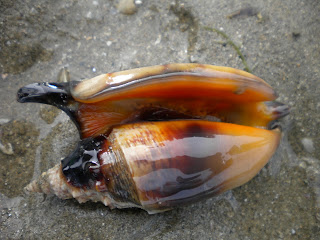Hopefully the persistent heavy rainfall will cease soon. Am worried that history will repeat itself and affect the marine life on our shores. It would be terribly heartbreaking to witness a sea of sea stars, sea cucumbers and anemones, dead instead of its usual vibrance.
I recall a conversation with a group of friends who 'laughed' at me for recycling paper from magazine as wrapping paper a few days back about Climate change. Despite the recent high level of publicity, some people are still ignorant of the issue. In fact, Singapore have tasted the effects of climate change with the recent frequent flooding, and now the case of the fish farms. While I am not the guru of this nor a good example, but I know everyone's little effort in cutting down carbon footprint will help.
Many a little makes a mickle.
There were also quite a few Pink Warty Sea Cucumber (Cercodemas anceps) (*editted) whose bright colours added some cheer to the depressing scene.
Looking a little different out of water, the sea cucumber displays its pretty feeding tentacles which it lashes in the water to feed on detritus.
The area was littered with money too - I wished! These dollar-coin look-alike is actually a Sand Dollar (Arachnoides placenta), think I saw more than 10 of them. Sand Dollars are actually flattened relatives of the sea urchins, and have short spines that helps it walk.
A great find from LK! I initially thought this was a snail, but was taught that this is actually a bivalve. It is called a Watering-Pot shell (Brechites penis), rather rare and often only an empty tube is found.
This one was actually alive still! The long shell-like tabular structure is rather misleading. Wondering where the 2 valves of the shell are? Take a closer look at the second photo, see the 2 halves? The two valves are reduced and fused onto the walls of the calcareous tube. This shell filter-feeds by its broader end which has tiny holes, resembling a watering can, probably how it got its common name.
There were lots of Window Pane shells (Placuna sp.), and I was lucky enough that this mollusc displayed its body for me to capture a shot (LK tried to take a photo, and the shell close its valves just at the time she was about to press the button).
The world cup fever was already felt at Changi Beach before the actually event kick off! Don't this Ball Sea Cucumber (Phyllophorus sp.) resembles a (polka-dotted) soccer ball? This sea cucumber is usually buried in sandy areas but this one, I think, was found hidden among the seagrass. It has short tube feet and the entire body is covered by filaments (papulae) which helps it hold on to the substrate. Uusally, only the branching feeding tentacles are seen lashing in the water for detritus when it is buried in sand.
I was overjoyed to see a Noble Volute (Cymbiola nobilis), which never fails to impress me with its beautiful shell and foot. Other clams and snails may not agree with me though, as the Noble Volute is their fierce predator. It suffocates its prey with its strong (but very bright and pretty!) foot, and attacks when the clams opens its valve in an attempt to breathe. This one that we spotted seems to be on the lookout for its next meal, as it was sensing the environment with its siphon.
A Biscuit Sea Star (Goniodiscaster scaber), looking as if it is cut out from a cookie cutter with its smooth and regular edges, was also spotted.
First time sighting a Frog snail (Bufonaria sp.) shell - I'm referring only to the shell because this one was occupied by a hermit crab instead. It seems that living Frog snails are rarely seen. I was told that its called a Frog snail because it looks like one, but hmm think it will need quite a fair bit of imagination to see the frog. Also read that it got its name from the warty texture of the shell. Hope to see a living Frog snail soon!
Another great find, this time by Samson! Takes a pair of sharp eyes to spot as conches like this Strombus aratrum is often very well camouflaged. This conch is on our endangered list as well, possibly due to overcollection for its shell and as food. It has a relatively thick shell and has a distinctive protruding edge at one end. Take a look at the underside that is completely of a different look from the outerside, isn't it beautiful?
Like its Spider Conch relative, the Strombus aratrum has a strong operculum that acts as a trap door and a clutch for it to leap around.
a pair of curious yet cautious eyes, how very adorable!
Squid egg capsules, hopefully they will survive and hatch into squids!
We initially thought this Moon Crab was yet another moult, and only believed that its alive when it moved slightly. We must be quite lucky because the Moon Crab is more active at night and usually buried in sand in the day. This one has purple spots on its body and is probably the Ashtoret lunaris. Not a great swimmer, the moon crab compensates by having peddle-like legs that helps it burrows quickly into the sand. Their 2 pincers fit snugly against its body for a box-like appearance.
A world map laid neatly on Changi Branch - these are actually formed by the sand balls created by Sand Bubbler Crabs (Scopimera sp.). Thought it looked like France on the world map.
Sand Bubbler crabs feeds on detritus on sand particles by scraping up sand grains with their downward pointing pincers to their mouthparts. The sand is then discarded in a little ball on either of its side when it moves thus forming a path amonst the piles of sand grains leading from the burrow entrance.
After staring for a few minutes, I started seeing the sandballs moving on its own. Nah, its not my eyesight nor imagination. Sand bubbler crabs are almost the same colour as sand, and as round as the sand balls they create. They bolt into their nearby burrows at the slightest sign of danger – like a moving ball of sand!
Can you spot the crab here?
Although I was very disturbed by the number deaths of the beach, it was still, overall, a good trip with many interesting sighting. Hopefully, the weather will turn for the better soon!






















2 comments:
no us hor?? we never laugh, we appreciate the education and it's a great idea which i intend to adopt!! :)
wahaha! of course not you all la!
Post a Comment